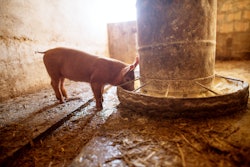
Compensatory growth is a real and natural phenomenon that occurs when an animal remains undernourished for some period of time. The animal’s whole metabolism shifts to increase the utilization of feed when in abundance.
The opposite is also true. For example, in humans, an excess of vitamin C intake will be excreted, whereas a paucity of intake will increase its absorption efficiency (a bit, but nature will give it a try). All these are basic (OK, not basic; they are Ph.D. level) metabolism.
Here comes practice. Compensatory growth takes time. This is why we observe it more easily in growing beef cattle. Here, we can adjust intake of nutrients according to season, prices, etc., and achieve a financial return that satisfies the producer without sacrificing animal welfare and health. This is not possible in the case of pigs, and especially piglets.
Countless research reports in the past 50 years have shown that the six months we allow pigs to grow until market age is not enough to exhibit compensatory growth. At least, in the cases where compensatory growth was found, it was just fat and not muscle.
There is a misconception among feed professionals and pig producers that a low-cost piglet nutrition program is more than enough. This might be the case as far as health and welfare are concerned, but growth cannot be maximized this way, at least if this is the desired goal. And pigs will not make it up later by eating more of a less expensive feed. In fact, modern genetics are verging near the point where they will no longer be able to adjust their intake according to dietary energy concentration. This is already acknowledged by certain nutritionists in the case of modern broilers.
When it comes to compensatory growth in pigs, one has to make an educated decision based not only on one research report, but on all of the work done over many years. In my line of work, I have seen this again and again, as a means of spending less on starting piglets on a strong basis. In the end, pigs either take longer to reach market weight, which might be alright if someone does not account for the cost of facilities, etc. In most cases, profitable pigs are those that make the best start.

















